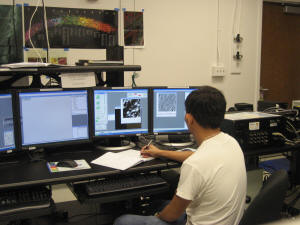|
|
| |
|
With two fume hoods,
several balances, an
ultracentrifuge,
ultrasonicator, drying
oven, fraction
collector, rotary
evaporator, and stills
for solvent
purification, our
laboratory contains all
necessary equipment for
the synthesis of
colloids and cluster
based materials. Of two
M.Braun glove boxes, one
provides the environment
for synthetic studies
involving
oxygen-sensitive
materials, whereas the
other box is available
for electrochemical
investigations using a
PC controlled PAR 263
potentiostat. The lab is
also equipped with an
Olympus BX51 microscope
and an Ocean Optics
HR2000 CG-UV-NIR
spectrometer--essential
tools for characterizing
the structures and
properties of our
nanomaterials. |
 |
|
|
|
|
For
compound/materials
characterization we make
extensive use of the
Materials
Science/Central
Facilities. It
houses the Scintag XDS
2000 Powder X-ray
diffractometer as well
as several electron
microscopes: an FEI
XL30-SFEG scanning
electron microscope, a
Philips CM12 100kV
(scanning) transmission
electron microscope and a
JEOL 2500SE (S)TEM. (Download
mpeg video (9.2MB))
|
 |
|
|
|
|
Further microscopic and
spectroscopic
characterization are
performed at the
Nanomaterials in the
Environment,
Agriculture, and
Technology Organized
Research Unit (NEAT-ORU)
Spectral Imaging
Facility.
Instruments here include
a Renishaw Laser Raman
microscope, a Hitachi
S-4100T FE-SEM/Oxford
EDS, an Olympus FluoView
Confocal Laser Scanning
microscope, and an
Asylum Research MFP-3D
atomic force microscope. |
 |
|
|
|
|
IR measurements are made
using a Mattson Galaxy
Series FTIR 3000. NMR
experiments are
performed on a Varian
Inova 400 MHz NMR
Spectrometer.
These are carried out in
the analytical and
NMR-facilities in
the chemistry building.
A single X-ray
diffractometer equipped
with a CCD is accessible
through the departmental
X-ray laboratory. |
 |
|
|
|
|
|
|
|
|
